You are using an out of date browser. It may not display this or other websites correctly.
You should upgrade or use an alternative browser.
You should upgrade or use an alternative browser.
Photos of the Kaiserreich
- Thread starter pattontank12
- Start date
Meanwhile, In Europe....

Imperial German forces move to the front line during the first days of the Second Weltkreig, September 1942. The collapse of peace was not unexpected, as border clashes had raged for decades and the two opposing sides became ever more openly hostile to each other.

Imperial German soldiers on the lookout for attacking French Worker’s Liberation Army soldiers in Flanders-Wallonia.

Italian Worker’s Liberation Army forces preparing for their attack into Alsace-Lorraine. The area was heavily defended by Reichspakt troops and saw some of the bloodiest fighting of the war in Europe.

French soldiers take cover as a German MG opens fire in a village, September 1942. Note the flamethrower on the second man’s back. Thanks to their effectiveness in the First Weltkreig, such weapons were used in disturbingly large quantities by both sides.
Imperial German forces move to the front line during the first days of the Second Weltkreig, September 1942. The collapse of peace was not unexpected, as border clashes had raged for decades and the two opposing sides became ever more openly hostile to each other.
Imperial German soldiers on the lookout for attacking French Worker’s Liberation Army soldiers in Flanders-Wallonia.
Italian Worker’s Liberation Army forces preparing for their attack into Alsace-Lorraine. The area was heavily defended by Reichspakt troops and saw some of the bloodiest fighting of the war in Europe.
French soldiers take cover as a German MG opens fire in a village, September 1942. Note the flamethrower on the second man’s back. Thanks to their effectiveness in the First Weltkreig, such weapons were used in disturbingly large quantities by both sides.
Any ideas what a 1960's Space Race would be like in the world of KR?
I'm rather partial to a European 'Nasa' style organisation vs Syndicalist efforts myself.
I'm rather partial to a European 'Nasa' style organisation vs Syndicalist efforts myself.
Infact, I've postulated just such a possibility here.

'Raumflugzeuge' OV-K101 'Apollo' and her Ariane 3 carrier rocket, in this case an example manufactured under license in Ukraine. Is seen here being prepared for RSS-F106 in the Vehicle Assembly building at Krasnokam Yanka in Ukraine on the 9th of March 1995. The Raumflugzeuge, meaning 'Space Aircraft' is a reusable Space craft operated by EASTO 'European Air and Space Treaty Organisation' as part of its reusable space system. Operated since 1981 the 'Raumflugzeuge-Ariane' has been the foremost means by which the nations of Mitteleuropa have gained access to space, the Raumflugzeuge was constructed by the German Empire, partially as a promise to insure a continuation of European space flight and partially to guarantee the use of National Frances Ariane series rockets. 5 'Raums' exist including Apollo, the other four are 'Athena', 'Aphrodite', 'Ares' and 'Atlas'. It should be noted that the Apollo was the first Raum and is the only craft operational from the start of the RSS program.
With her enormous payload bay, the Raumflug can easily carry any component or supplies into low earth orbit, plus a full complement of up to 10 Cosmogators. This allows her to interact with European satellites and Space stations. One thing of note is the Apollo herself is a payload for the Ariane which can be operate independently to launch loads and capsules beyond Earth Orbit, such to the International Moon Base. The four boosters, known as 590s, are also reused, designed to parachute and land in the Republic of Siberia, however the core stage of the Ariane, which carries the 4 main engines of the rocket, cannot be recovered and thus must be replaced after every launch. The Raumflug itself carries two small orbital maneuvering engines which are only fired after separation and cannot be used on launch.
Despite allowing greater flexibility to Easto in terms of space station construction, craft deployment and satellite maintenance the 'Raumflug-Ariane' has not achieved the cost savings that was once hoped for. This is put down to the expense of requiring a 'Lunar capable' rocket to launch to low orbit and the necessity of building a new one for every launch, worst still refurbishing the 590s is costly to Easto as well, and as this photograph aptly demonstrates the amount of pre-launch preparation required. Despite this the Raumflug is arguably the most recognizable Space Craft in the world today and serves as an ambassador for European space flight.
Imperial German troops during an inspection, October 1942. Despite intense drilling and training during the interwar years, a good majority had never seen real combat and were mentally unprepared for what was to follow.
Imperial German Army soldiers on the move during Operation Friedrich, November 1 1942. The operation was the first counter-offensive conducted by the Reichspakt of the war. However, the offensive was quickly blunted by stiff, almost fanatical CoF and UoB resistance. German commanders abandoned the plan of attacking the French Commune through Flanders-Wallonia, fearing a repeat of the trench warfare of the First Weltkreig.
British Worker’s Liberation soldiers during a lull in the Battle of Mons, late October 1942. Note the Russian-made machine gun - Russia gave some material assistance to the Internationale in an effort to bring down their old German rivals. The battle itself closed with a stalemate, and Operation Friedrich evicted the BWLA forces in November.
An Italian political officer interrogates a captured German soldier, November 1942. The German officer was most likely executed shortly afterward, as Internationale forces had a tendency to execute anyone they deemed a “counter-revolutionary” - including PoWs. Eventually, the practice was stopped by early 1943, once Internationale political leaders realized the POWs were a valuable source of slave labor.
Last edited:

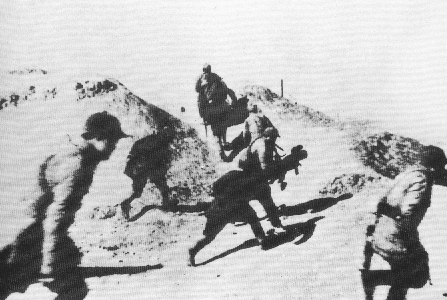
Left KMT troops in the Lower Yangtze offensive.
according to the instructions of the Central Committee of the Kuomintang , the new divisions and brigades no longer belonged to the military region and the military division, and the Huaibei Military Region organs were also established.
Note all of my China pictures take place in a modified version of @theg*ddam*hoi2fan timeline with the China rework grafted in
Last edited:
The remains of Amiens after three German “tidal wave” bombing attacks, January 1943. The “tidal wave” tactics dictated for German air forces to obliterate any target deemed useful to the Internationale war effort - usually by enormous fleets of bombers destroying the city through incendiaries, chemical and conventional bombing.
German military police troops burn a suspected Syndicalist safehouse in the South of Germany. The southern Franco-German border was a known hotspot for spy activity that, despite the best intelligence efforts, raged mostly until the Second Weltkreig drew to a close.
Imperial German shock trooper, 1943, an image that made the cover of several German magazines. Much like the First Weltkreig, many soldiers on both sides quickly realized the war wouldn’t be over with a quick victory, and would be a brutal slugging match neither side could afford to lose.
Internationale forces during the Great Winter Offensive, December 1942. The Internationale command correctly guessed that many German soldiers would be distracted by the upcoming Christmas season (a holiday that had been banned in the Syndicalist countries), and thus would be caught off guard. The High Command ordered an offensive to take place on December 25. Starting with an overwhelming artillery barrage, the attack broke through the line on the 27th, and within days French Commune soldiers were parading down the devastated, terrified streets of Zweibrücken.
Threads (1984) is an adaptation of the 1954 Eric Arthur Blair novel of the same name. It is a prequel to his controversial book 1984 (1948). Both Threads and 1984 were made in Blair’s later life, showing his growing criticisms of Totalitarian Socialism. In it, The Third Weltkrieg breaks out between Germany and Mongolia, The Federation of Great Britain, the successor state of the Union of Britain, being an ally of Germany and major member of ISAF (International Security Allied Forces), is a target of nuclear bombing. The target, Sheffield, is where the main protagonist, Ruth Beckett, lives. It chronicles her life before, during, and after 3WK. The story ends 1 year before 1984, with Jane Beckett, the daughter of Ruth, being raped, and eventually giving birth to a stillborn baby in front of the book’s sequel’s main protagonist, Winston Smith, who was in the St. John’s Hospital at the time. Threads, and it’s sequel, 1984, were banned under the British government due to implying that the Maximists would regain power, albeit after a Nuclear War. Both stories were unbanned in 1977.
Based on this DBWI thread:
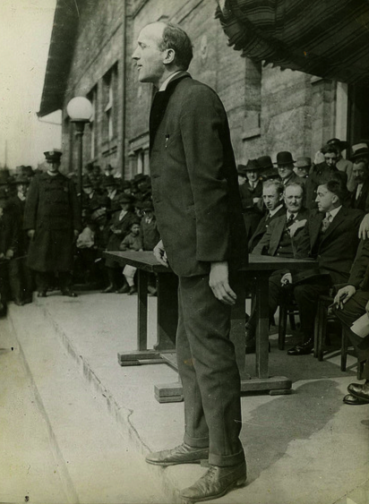
Chairman William Z. Foster (1881-1942) was the second leader of Red America, being the Chairman of the USAS and the leader of the centralist faction of the Socialist Party of America from 1938 until his death in 1942. His government was marked by the reconstruction of most of america under his totalist viewpoint, the expansion of the trade union system, the stabilishment of the dictatorship of the proletariat and the CIA. Shortly after a very controversial testimony delivered by a cleary tortured Henry Wallace on the congress he was removed by a military coup by Field Marshall Smedley Butler, killing him in the process.

Chairman William Z. Foster (1881-1942) was the second leader of Red America, being the Chairman of the USAS and the leader of the centralist faction of the Socialist Party of America from 1938 until his death in 1942. His government was marked by the reconstruction of most of america under his totalist viewpoint, the expansion of the trade union system, the stabilishment of the dictatorship of the proletariat and the CIA. Shortly after a very controversial testimony delivered by a cleary tortured Henry Wallace on the congress he was removed by a military coup by Field Marshall Smedley Butler, killing him in the process.
The Vickers gun is not the worst war booty to have. When the UK retired the last of them in the 1960s (which is in itself a sign of how good it was, given that it's basically a souped up maxim with some parts built upside down) they took one, measured it out to as close to factory spec as they could and put no less than 7 million rounds through it, only pausing for switching crews and barrel change. Damn thing still ran when they were done.
Deleted member 82792

Photo of American Airborne and Walloon partisans outside Charleroi during the Operation Scythe, the first major offensive victory on the Western front for the Internationale.
Operation Scythe first entered the planning stages following the Internationale's victory at 2nd Verdun in August 1940. Initially conceived as a primarily armoured operation with mainly American and French troops by Field Marshals Makhno and Butler, it was later given a third angle of attack in the form of the new American Airborne Corps and renewed contact with Walloon and Flemish partisans. For their part the Reichspakt Unified Command assumed that any counteroffensive would take place in Alsace-Lorraine, but they nonetheless realised that something would be happening in Walloonia, and reinforced the region with a mix of Baltic and Danubian troops, bolstered by some of the older obsolete but still dangerous German armoured divisions.
The operation initially ran into several difficulties when it was launched in November of 1940, the Walloon partisans were for the most part crushed outside a handful who linked up with the airborne divisions in Chareloi, and the Luddendorf line took a full week longer than expected to break before the American tanks. Any opportunity for the Germans to capitalise on these gains however was rendered moot when the Swedish Commune fulfilled its part of the bargain, landing 2 divisions of the Peoples Marines directly into Antwerp with the help of the Flemish Liberation Front and taking the city. Suddenly almost half the Reichspakt forces in former Belgium were cut off from their supply lines.
Operation Scythe officially ended on the 19th of February 1941 as a minor tactical victory for the Internationale, but a massive propaganda victory. Though the Baltic and German elements had been able to withdrawn from Walloonia in its entirety and western Flanders, the Danubian elements had almost a 50% casualty rate and 2 entire divisions captured as prisoners of war. Operation Scythe ultimately set the stage for the entry of Japan and Russia into the 2nd Weltkrieg as they realised the fragility of the world order the Germans led.
Last edited:
MadFrog
Banned
I'm sorry, but English is not my mother tongue, so I use the Google translator.
Very good, but I have a few complaints:
I think that the Red French will get rid of the Adrian helmet. The “Adrians” will definitely remain with the loyalists in Africa (since there will not be enough industry for the development of new equipment, moreover, the scheme has been worked out). But the Reds, who are preparing in advance to a war for the World Revolution, will have not only opportunities, but also an incentive to improve equipment to meet the requirements of the time. And in the 30s. Adrian's helmet does not meet the requirements of the time - maybe it will remain with the police and firefighters, but this is the maximum. And for the army, the French will either develop a new helmet, or borrow from one of the allies of the International. If you interesting, then I think that the Italian helmet M33 will be a good candidate, unless, of course, it is developed in Socialist Italy, and not in some other.
The round cap, which the commissar wears on art, is most likely not to be represented in the French Commune army, for the same reason that in Soviet Russia refused shoulder straps - is associated with the old imperialist officers. I think they will refuse a round cap and instead introduce a chekist-style cap.
Share:
